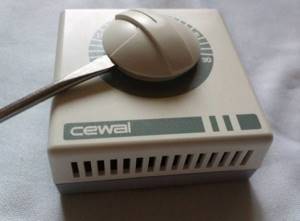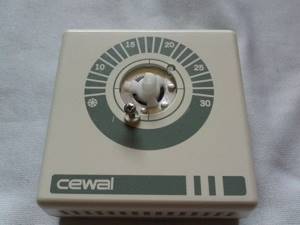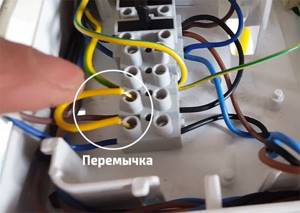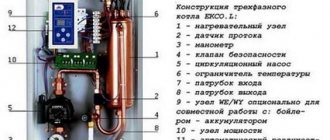Some simple models of electric boilers do not have smooth power adjustment, not to mention wider functionality. But even with degree-by-degree adjustment, the operation of the automation is based on measuring the temperature of the coolant in the supply and return of the boiler, which is not entirely effective: high accuracy cannot be achieved; high inertia is characteristic, i.e. a rather slow change in air temperature in the house.
But the main thing is that in the absence of precise adjustments, a lot of electricity is wasted.
The problem can be solved by installing a special room thermostat (thermostat) for an electric boiler, more expensive models of which measure the air temperature in the room and regulate the boiler operating mode in accordance with it, which is more correct and, most importantly, allows you to save from 10 to 50% of electricity. Moreover, the price of the issue is only 800-1000 rubles for simple mechanical models or 3-5 thousand rubles for more functional programmable thermostats controlled from a phone.
What are thermostats for an electric boiler?
Why are they needed and how are they used?
Simple mechanical thermostat.
The temperature regulator is a wired or wireless control panel that is mounted on the wall in any convenient place.
There are both simple mechanical models, the functionality of which is smooth degree-by-degree temperature control (especially important for electric boilers with mediocre 3- or 6-step power control), and automatic programmable models with an information display, which allow you to configure more than 50 parameters of the boiler operation and program them change for the next day or even week.
Automatic thermostats allow you to adjust the operation of the boiler once and up to a whole or even several heating seasons.
In general, room thermostats for electric boilers perform the following functions:
- measurement, control and maintenance of a certain comfortable temperature of the working environment;
- transmitting signals to the electric boiler from any place in the house convenient for the owner;
- protection against overheating or freezing of the heating system;
- programming the operating mode for the next day or week;
- remote control from a phone if the thermostat has Wi-Fi or a GSM module;
- remote notification (including via smartphone) about malfunctions and emergency situations in the operation of the heating system.
Existing types
The settings specified on the thermostat take precedence over the settings of the electric boiler itself. The operating principle of the device depends on the type of temperature sensor used in it:
1. Mechanical thermostats
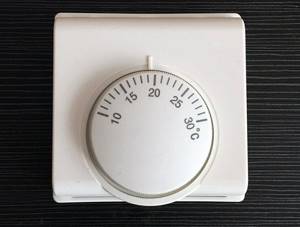
The simplest models, the operating principle of which is based on the operation of membrane and capillary temperature sensors. They use substances placed in a capsule that expand significantly at the slightest increase in temperature. When the expanding substance reaches the maximum temperature threshold, it puts pressure on the relay membrane, as a result of which the contacts open, and the thermostat sends a signal about a partial or complete reduction in the power of the electric boiler.
The main disadvantages of such thermostats are simple functionality, limited to turning a round rotator to set the desired temperature, and a high error - up to 3-4°C.
2. Electromechanical

They have a more complex design based on the use of special metal plates as a heat-sensitive element, which produce a micro-discharge when heated to a certain temperature. The micro-discharge activates an electromagnetic relay that controls a mechanical valve. In general, electromechanical thermostats have +- the same functionality, but a much smaller error; their cost is 20-40% higher.
3. Electronic
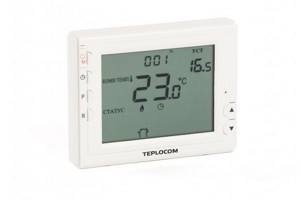
The most modern and multifunctional devices, equipped with electrical boards (automation), often with remote sensors: both internal and external (street). Capable of maintaining or changing the operating mode of an electric boiler without human intervention. Allow a minimum error of up to 0.5-0.7 degrees. We recommend paying attention to electronic thermostats due to their functionality and cost-effectiveness.
The automation of modern models is capable of maintaining the most economical mode of operation of the electric boiler, constantly adjusting its operation in accordance with the temperature in the working room, which completely prevents unnecessary energy consumption. After all, reducing the temperature by 1°C is up to 5% savings.
How to choose an external temperature sensor and organize weather-dependent boiler control
ROOM MECHANICAL TEMPERATURE REGULATOR
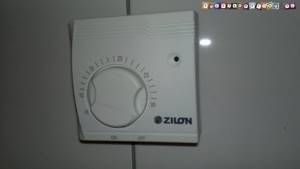
A room mechanical thermostat is a device that regulates the operation of climate control equipment, maintaining the set temperature parameters of the room. Can be used for both heating and cooling an apartment or house.
The main difference between mechanical room thermostats and other types of thermostats is that they are a separate, completely independent device, most often made in the form of an external electrical installation product, intended for installation inside residential premises.
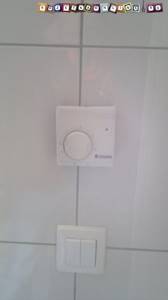
To put it simply, a mechanical thermostat, depending on the set program, turning on or off certain heating or cooling devices, maintains the required temperature in the room.
The main feature of a mechanical thermostat is the complete absence of electrical components, i.e. It does not require power, not even batteries, to operate.
How does a mechanical thermostat work, what exactly allows it to measure the temperature of the surrounding space and control electrical appliances?
How to choose a room thermostat for an electric boiler
Mounting and connection method
According to the technique of fastening and connecting to the electric boiler, wired and wireless devices are distinguished.
Wired thermostats can still be installed in any room, can have any functionality, but require a wired connection directly to the electric boiler. Their cost is lower, and in most cases the connection wire is included.

Wireless temperature controllers consist of a control panel and a radio signal receiver connected to the electric boiler by wire. The advantages are obvious: when placing the thermostat in a room remote from the installation site of the electric boiler, there is no need to lay an additional electrical wire through the entire house.
According to practice, a radio signal with a frequency of 433 or 868 MHz intended for household appliances does not affect other electronics in the house and is transmitted without problems through any walls at a distance of 20 and even 30 meters. The disadvantage is the need for additional power for the control panel, usually 2 standard AA batteries.
Functionality
Standard simple models only have an on/off switch and a rotator (or “+” “-“ buttons) to set the temperature.
For significant savings, it is better to choose a more expensive programmable thermostat, which will pay for itself in the first few months of use. With its help, you can reduce the room temperature to 15-16°C when everyone has gone to work, or to 18-19°C at night. It is enough to set up several electric boiler operating patterns once, the duration of which can range from 8 hours to 7 days.
In addition, programmable models, in addition to the built-in temperature sensor, are often equipped with additional remote ones, including those for heated floors.
Availability of Wi-Fi or GSM module
The built-in GSM module allows you to receive notifications via SMS messages about the operation of the heating system or about an emergency situation that has occurred, which you can immediately solve. This way the coolant will not freeze during a long absence of the owners.
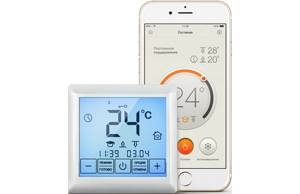
The presence of Wi-Fi allows you to control the operation of the electric boiler through an application on your smartphone. Also, via a Wi-Fi network, you can connect a thermostat to a smart home system or connect several additional temperature sensors (including underfloor heating). The presence of Wi-Fi and GSM does not affect the efficiency and economy of the heating system, but increases the comfort of its use.
Protection and safety
Budget and even some models of electric boilers in the mid-price segment may lack basic safety elements such as overheating protection, frost prevention mode, or protection against stopping the circulation pump. However, all these elements are found even in many simple models of thermostats in the price range of 1,000-1,500 rubles.
Such security systems especially should not be neglected when temporarily living in a house, when the owners are absent for days or weeks, but the heating system maintains a positive temperature.
Rating of top 5 thermostats for electric boilers
Without certain information, you can spend a lot of time choosing a good device, so I have compiled five points that will demonstrate the differences between models from different manufacturers.
Guided by the facts provided, which were collected by monitoring reviews and opinions of experts, you will be able to prepare for a successful purchase long before visiting the store.
Teplolux MCS 350
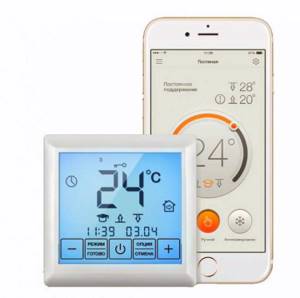
First place went to this Russian-made product; the touch screen is quite convenient, and the possibility of independent installation will be a nice addition.
The functions can be controlled via the Internet, which makes the thing practical. It is impossible not to note the efficiency; when calculating payment receipts, you can find figures of 70%. Among the positive aspects it is worth highlighting:
- Value for money.
- Remote control via the SST Cloud program.
- Electricity consumption statistics are available.
- IP21 protection.
Terneo RK 32A
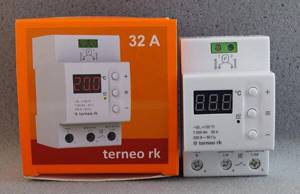
In second place in the rating was a unit distinguished by a rare body shape; it is somewhat unique, but this did not have a detrimental effect on productivity. It can be used for a boiler, heated floors, the three-digit screen will seem simple, the brightness and contrast remain at a high level.
You can only configure all the indicators manually; the advantages include:
- High degree of protection.
- Possibility to regulate pipe heating.
Caleo C450
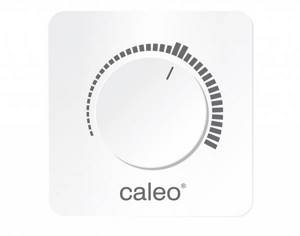
The third place was secured by a room thermostat with an affordable price; it involves the installation of a surface-mounted version. Mechanical control allows you to level the temperature from 10 to 35 degrees, there are specific points that you need to get used to.
Due to the simplicity of the device, the price is quite low; any owner can afford to purchase the model. Among the shortcomings, it is worth noting the lack of gradation, there are only divisions around the knob, for some people this will create some difficulties. The package includes two sensors, one is responsible for the temperature, and the second starts the self-diagnosis mode.
There are few advantages:
- Low price.
- Moisture protection.
Nest Learning Thermostat 3.0
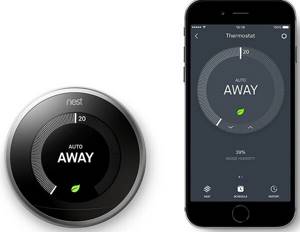
Fourth place went to a functional device that costs a lot of money; some functions, due to their abundance, even seem superfluous. Visually, the unit resembles a hockey puck, the display is very bright and on it you can easily see all the data about the system.
The rotary ring is used for control; there is the possibility of wireless regulation. Automation can safely be called widespread, but the model will be in demand exclusively in a “smart home”. Manufacturers have noticed that if the device is placed in the far corner from the electric boiler, problems with some functions may arise.
REXANT R200
The last fifth place was occupied by a device with a large touch display; the package includes an external and internal sensor. It is possible to control not only the heating system equipment, but also the heated floor, as well as infrared elements.
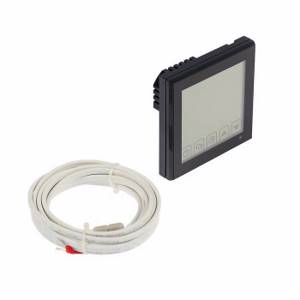
Some owners will like the fact that the device can be programmed for 6 periods of time, configured at their discretion, and it will work for the entire coming week.
According to the manufacturer, the thermostat for an electric boiler is capable of turning off the equipment when the temperature in the system rises to the maximum safety level. Most users questioned the protection against moisture and dust according to IP20; at the slightest contact with liquid, the device gets confused and gives inaccurate readings.
There are often specimens that work for no more than 6 months, which should be considered a defect. The positive aspects include touch control and dual-zone metering.
The best known manufacturers and models: characteristics and prices
Cewal RQ-10
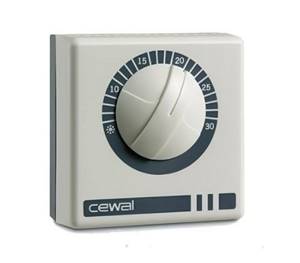
One of the simplest and most budget-friendly mechanical thermostats from an Italian manufacturer. Despite its low cost, it is known for its build quality and reliability. The instructions for the device provide a schematic and detailed description of the installation and connection algorithm. The only drawback is the large hysteresis - up to 1.5-2.5 degrees, which is typical for all mechanical thermostats.
SKAT Teplocom TS-2AA/8A
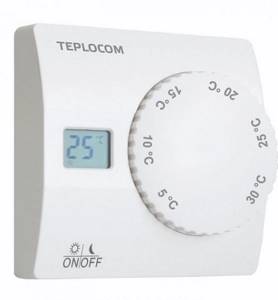
A more advanced thermostat with an error of up to 1°C. It has a micro-display for indicating temperature, powered by 2 AA batteries (enough for 10-15 months). It features an economical night mode with automatic temperature reduction by 4°C and frost protection.
Danfoss ECtemp Next Plus

One of the best thermostats for an electric heating boiler in terms of price-quality-functionality. It is a modern electronic programmable thermostat with a stylish design and wide functionality. In addition to the built-in one, it has an external wired temperature sensor for heated floors, which allows control separately from the air temperature in the room. Wide functionality, programming and the presence of ready-made modes (“night”, “away”, etc.) allow for maximum energy savings.
It is also distinguished by its safety: it has protection against overheating and freezing, child locking, and monitoring the health of temperature sensors. According to installation practice and owner reviews, there were no cases of malfunction. To avoid malfunction, during installation it is necessary to accurately fit into the grooves of the plug connector.
TEPLOLUX MCS-350
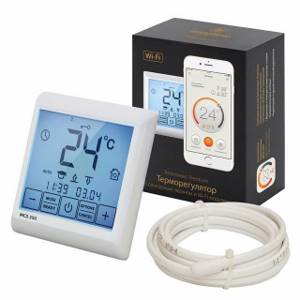
A modern multifunctional premium thermostat with a built-in Wi-Fi module and the ability to control using a special application for a smartphone. It features one of the most extensive functionality, an informative touch screen (with automatic locking) and a stylish design. The kit includes both built-in and remote temperature sensors for simultaneous or separate control. Additionally, you can connect up to 32 temperature sensors.
There are template energy-saving operating modes and weekly programming, as well as energy consumption statistics. The connection must be made via a modular contactor.
Mechanical thermostat device
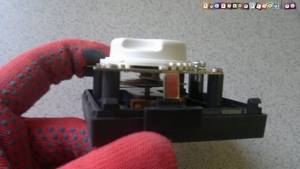
The main structural element of almost any room mechanical thermostat is a gas membrane. By the way, this is why they are often called membrane thermostats.
The special gas located inside the membrane, when the temperature changes, changes its volume, thereby affecting the walls of the membrane. Which, changing, trigger the mechanism of closing or opening the electrical circuit that supplies the heating or cooling system.
The choice of this particular method of device for a room thermostat is due to the possibility of organizing a simple way to adjust its operation temperature, as well as the fact that the device responds precisely to changes in air temperature, and not the surface, which is most important in heating and cooling systems. Therefore, for example, for heated floors it is more reasonable to use mechanical liquid thermostats with a remote sensor.
Adjustment of the response temperature of a membrane room thermostat is carried out using a control wheel with a scale, which is connected to the membrane mechanism. By turning the wheel, we move the membrane walls closer or further away from the control mechanism, thereby changing the temperature at which the electrical circuit will close or open. In other words, if the triggering mechanism is closer to the wall of the membrane, then the gas located in it only needs to change slightly in volume for it to trigger; accordingly, a lower temperature will be needed and vice versa. The adjustment wheel works on this principle.
Let's look at exactly how a mechanical thermostat can be used in the heating system of a house or apartment.
Correct connection of the thermostat to the electric boiler
When choosing an installation location, it is necessary to take into account that:
- installation near windows, ventilation or entrance doors is not recommended due to constant temperature changes;
- heated air masses are concentrated near the ceiling, closer to the floor the temperature is lower, so it is recommended to install the thermostat at a height of 1-1.5 m;
- household appliances in the kitchen can generate heat, which affects the accuracy of measuring the overall climate in the workroom;
- Installation too close to a frequently closed door is not recommended;
- Direct connection is not recommended if the load exceeds 10 A (connection is made through a modular contactor).
Connection instructions using the example of a mechanical Cewal RQ-10:
| Photo | Process description |
| Remove the rotator |
| Unscrew the screws by removing the front cover of the thermostat |
| Attach the device to the wall using the appropriate holes |
| Connect the ground. According to the diagram in the photo (click to enlarge), it is necessary to connect the thermostat contacts to the electric boiler board. |
| Individually . There may be a jumper between the “TA” contacts of the boiler board; it must be replaced with a two-core insulated cable with a conductor cross-section of 0.5-0.75 mm2. |
Modern thermostats are powered by AA batteries, but they may also need to be connected to an electrical outlet according to the diagram below:
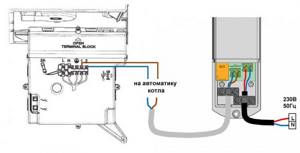
Connection diagrams and a detailed algorithm are described in the instructions for each thermostat. However, each case is individual and requires certain basic knowledge and skills. Therefore, the traditional advice is to contact specialists in case of difficulties and difficulties.
